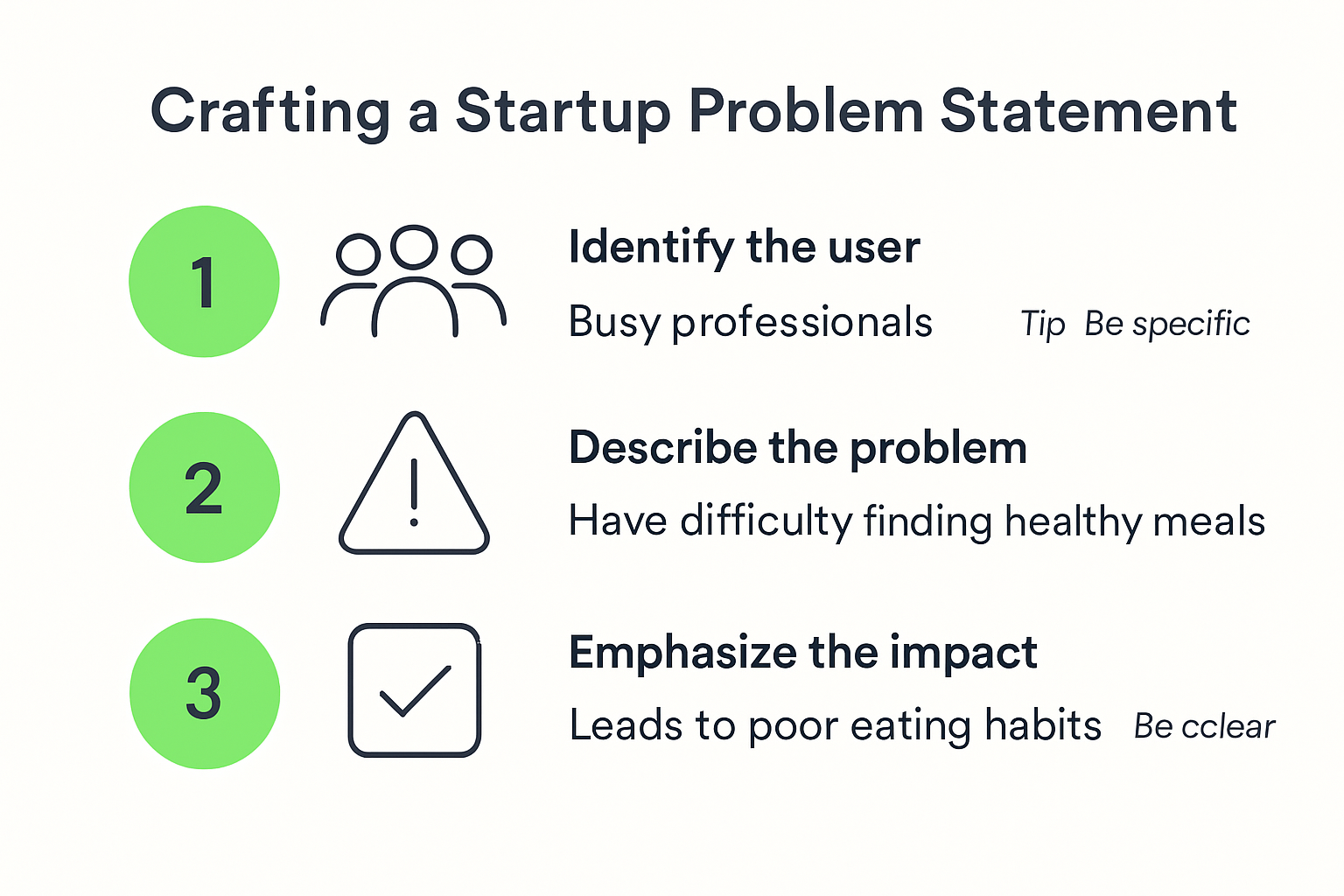
How to Pitch Ideas in 2025: A Guide for Aspiring Founders
Pitching a startup idea in 2025 can feel daunting, especially with investors hearing hundreds of proposals every month. Here’s the twist. Research shows that a focused problem statement and clear narrative can make your pitch 70 percent more memorable to decision makers. Turns out, what separates breakthrough proposals from forgotten ones is not complexity or buzzwords but how sharply you tell your story and explain your solution.
Table of Contents
- What Makes A Winning Pitch Today
- The Problem Statement: Your Pitch’s Foundation
- Storytelling: Making Your Pitch Unforgettable
- Market Potential: Proving Your Opportunity
- Crafting Your Idea For Non-Business Audiences
- The Power Of Storytelling
- Visual Communication Strategies
- Language And Accessibility
- Presenting Your Pitch With Impact
- Structuring Your Pitch Perfectly
- Mastering Vocal And Physical Presence
- Handling Questions And Uncertainty
- Common Mistakes To Avoid When Pitching
- Vague Value Proposition
- Data Overload And Complexity
- Neglecting Team Credibility
Quick Summary
What Makes a Winning Pitch Today
In the rapidly evolving startup ecosystem of 2025, crafting a winning pitch requires more than just a great idea. It demands a strategic approach that combines storytelling, market insight, and compelling problem-solving.
The Problem Statement: Your Pitch’s Foundation
Every successful pitch begins with a crystal-clear problem statement. Research from Emory University suggests that investors are fundamentally looking for founders who can articulate a specific, urgent problem that needs solving. This isn’t about presenting a generic challenge but pinpointing an exact pain point that resonates with your target audience.
Your problem statement should be razor-sharp. Consider it the surgical instrument of your pitch. Instead of saying “people struggle with time management,” say something like “knowledge workers lose an average of 2.5 hours daily due to inefficient workflow tools, resulting in $35 billion of lost productivity annually.” Specificity transforms a vague concept into a compelling narrative.

Storytelling: Making Your Pitch Unforgettable
Entrepreneurship experts at Arizona State University emphasize that storytelling isn’t just a nice-to-have technique—it’s a critical component of a winning pitch. Investors don’t just invest in ideas. They invest in founders who can weave their vision into a narrative that’s both emotionally compelling and logically sound.
Effective storytelling in pitches follows a simple arc: introduce the problem, show your unique understanding, and reveal how your solution transforms the current landscape. Think of your pitch as a hero’s journey where your startup is the protagonist solving a critical challenge.
Market Potential: Proving Your Opportunity
Beyond storytelling and problem definition, investors want concrete evidence of market potential. Market research indicates that founders who can precisely demonstrate their target market’s size, growth trajectory, and economic opportunity stand out.
This means going beyond surface-level market size estimates. Break down your total addressable market (TAM) into serviceable addressable market (SAM) and serviceable obtainable market (SOM). Show not just how big the market is, but how much of it you can realistically capture with your innovative solution.
Successful pitches in 2025 are strategic conversations. They’re not just presentations but dialogues that demonstrate your deep understanding of the problem, your unique approach to solving it, and your ability to execute. Remember, investors are betting on you as much as they’re betting on your idea.
Your pitch is your startup’s first impression. Make it count by being precise, passionate, and pragmatic.
Here’s a table summarizing the essential components and key tips for a winning pitch as described in this section:
Crafting Your Idea for Non-Business Audiences
Translating a complex business concept into language that resonates with non-business audiences requires more than technical knowledge. It demands empathy, strategic communication, and the ability to make abstract ideas tangible and compelling.
The Power of Storytelling
Research from SpeakerHub reveals that storytelling is a universal language that transcends professional boundaries. For founders pitching to non-business audiences, this means transforming your idea from a technical concept into a human narrative.
Effective storytelling isn’t about dumbing down your idea. It’s about creating a journey that people can emotionally connect with. Start by framing your concept around a relatable human problem. Instead of explaining technical details, describe the real-world challenge your solution addresses. For instance, rather than discussing complex algorithm architecture, explain how your technology helps working parents save time or reduces environmental waste.
Visual Communication Strategies

LinkedIn professional communication research demonstrates that visual aids are critical in breaking down complex information. Graphs, infographics, and simple illustrations can transform abstract concepts into digestible insights that anyone can understand.
Consider creating visual metaphors that translate your business idea into everyday language. If you’re developing a software solution, compare its functionality to something familiar like a helpful assistant or a Swiss Army knife. Use analogies that bridge the gap between technical complexity and everyday experience.
Language and Accessibility
Communication experts recommend tailoring your communication by eliminating industry jargon and focusing on practical implications. Your goal is to help listeners understand not just what your idea does, but why it matters in their lives.
Practical communication means answering three fundamental questions for your audience: What problem does this solve? How does it make life easier? Why should they care? Construct your pitch around these core inquiries, using clear, conversational language that feels more like a dialogue than a presentation.
Remember that non-business audiences are diverse. A college student, a retired professional, or a community organizer will interpret your idea through different lenses. Your communication must be flexible enough to resonate across various backgrounds and experiences.
Ultimately, crafting your idea for non-business audiences is about building bridges of understanding. It’s less about impressing people with technical brilliance and more about helping them see how your solution can positively transform their world.
The table below highlights communication strategies tailored specifically for non-business audiences as described in this section:
Presenting Your Pitch with Impact
In the high-stakes world of startup pitching, your presentation is more than just words. It’s a performance that can make or break your opportunity to secure funding, partnerships, and support.
Structuring Your Pitch Perfectly
Research from Emory University reveals that successful pitches follow a strategic structure. Your presentation should flow like a compelling story with clear, distinct chapters: problem statement, unique solution, market analysis, business model, and financial projections.
Think of your pitch as a carefully choreographed dance. Each section should seamlessly transition into the next, creating a narrative that feels both logical and exciting. Start with a hook that grabs attention immediately. This could be a startling statistic, a provocative question, or a personal anecdote that illustrates the problem you’re solving.
Mastering Vocal and Physical Presence
Entrepreneurship communication experts emphasize that delivery is just as crucial as content. Your body language, facial expressions, and vocal dynamics communicate your passion and credibility.
Voice modulation research demonstrates that varying your vocal pitch, volume, and speed can dramatically enhance audience engagement. Imagine your voice as an instrument. Soft, contemplative tones when describing the problem. Energetic, confident pitch when explaining your solution. Subtle variations keep listeners attentive and emotionally connected.
Handling Questions and Uncertainty
No pitch is complete without the potential for challenging questions. The most successful founders view Q&A not as a threat, but as an opportunity to demonstrate depth of knowledge and adaptability.
Prepare for potential questions by anticipating critical inquiries. What are the potential weaknesses in your business model? How might competitors challenge your approach? Practice responses that are honest, confident, and forward-looking. If you don’t know an answer, it’s better to say “I’ll get back to you with detailed information” than to fumble or appear defensive.
Remember that investors are not just evaluating your idea but assessing you as a founder. Your ability to communicate clearly, handle pressure, and show genuine passion speaks volumes. A pitch is more than a presentation. It’s a window into your potential as a business leader.
Practice doesn’t just make perfect. It makes your pitch feel natural, authentic, and compelling. Record yourself. Get feedback. Refine your delivery. In the world of startup pitching, preparation is your greatest competitive advantage.
Common Mistakes to Avoid When Pitching
Pitching a startup idea is like navigating a minefield. One wrong step can derail your entire opportunity. Understanding and avoiding common pitfalls can significantly improve your chances of success.
Vague Value Proposition
Research from Raise Money Ventures reveals that founders often fail by presenting unclear or generic value propositions. Investors hear hundreds of pitches. If you cannot succinctly explain what makes your solution unique within the first 30 seconds, you’ve likely lost their attention.
Avoid broad statements like “we want to help businesses.” Instead, craft a laser-focused value proposition. For example, “We reduce customer service response times by 67% using AI-powered chatbots specifically designed for small e-commerce retailers.” Specificity transforms a bland concept into an intriguing opportunity.
Data Overload and Complexity
Startup funding experts warn against overwhelming investors with excessive, complex data. While metrics matter, drowning your audience in spreadsheets and technical jargon can obscure your core message.
Focus on telling a clear, compelling story supported by key metrics. Choose 3-4 critical data points that demonstrate market potential, growth trajectory, or competitive advantage. Use visual aids like graphs or infographics to make complex information digestible. Remember, investors are looking for potential, not a doctoral dissertation.
Neglecting Team Credibility
Seedcamp’s investment research emphasizes that investors invest in people as much as ideas. Failing to showcase your team’s qualifications and relevant experience can significantly undermine your pitch’s credibility.
Don’t just list job titles. Highlight specific achievements that demonstrate why your team is uniquely positioned to execute this vision. Did a team member previously scale a successful startup? Has someone solved a similar technical challenge? Concrete examples build investor confidence.
Additionally, be transparent about skill gaps. Showing self-awareness and a strategic plan to fill potential expertise holes demonstrates maturity and strategic thinking.
Pitching is an art form that requires practice, self-awareness, and strategic communication. Each mistake is an opportunity to refine your approach. By avoiding these common pitfalls, you transform your pitch from a potential rejection into a compelling investment opportunity.
Remember, investors are not just buying an idea. They’re betting on your ability to navigate challenges, adapt, and turn vision into reality. Make every word, every slide, and every moment count.
Frequently Asked Questions
How can I create a compelling problem statement for my pitch?
A compelling problem statement should be specific and urgent. Clearly articulate the exact pain point your startup addresses, supported by relevant data to demonstrate its significance.
What storytelling techniques should I use in my pitch?
Effective storytelling frames your pitch as a narrative that includes the problem, your unique solution, and the journey of your startup. Engage your audience emotionally and logically by relating the startup’s mission to real-world challenges.
How can I demonstrate market potential in my pitch?
Break down your total addressable market (TAM) into serviceable addressable market (SAM) and serviceable obtainable market (SOM). Provide realistic strategies for market capture and concrete evidence of the growth potential.
What common mistakes should I avoid when pitching?
Avoid vague value propositions, data overload, and lack of team credibility. Clearly articulate what sets your solution apart, use impactful data selectively, and highlight the qualifications and achievements of your team.
Struggling to Perfect Your Pitch? siift Turns Clarity Into Action
Many aspiring founders hold back because pitching feels overwhelming. The article you just read highlights common stumbling blocks like vague problem statements, unclear market evidence, and uncertainty in communicating complex ideas. If you crave step-by-step support to sharpen your value proposition, tell a story that resonates, and clearly define your market opportunity, siift is built for you.
Take the uncertainty out of your founder’s journey. Let siift’s intuitive AI provide personalized, bias-free feedback, practical insights, and prioritized next steps. Whether you are refining your pitch or starting from scratch, unlock your path to a standout presentation today. Get started with siift and transform your big idea into a business reality the smart way.

see where you stand





.svg)
.svg.png)



.svg)

